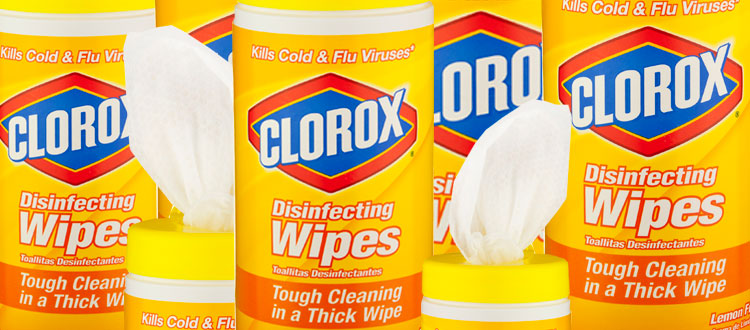Common Antimicrobial Chemicals Found in Household Disinfectants
Chlorine bleach is commonly used to treat drinking water, sanitize swimming pools and to whiten laundry, and is a strong eye, skin, and respiratory irritant. Mixing chlorine bleach with other cleaners like ammonia can release dangerous chlorine gas. Exposure to chlorine gas can cause coughing, shortness of breath, chest pain, nausea, or other symptoms.
Ammonia is often included in glass cleaners and other hard-surface cleaners, and can be irritating to the skin, eyes, throat, and lungs. Ammonia can burn your skin, and can damage your eyes (including blindness) upon contact.
Triclosan and Triclocarban are commonly added to household cleaning products such as hand soap and dish soap as well as a broad range of other products from toothpaste to socks. These chemicals are persistent in the environment, and are linked to hormone imbalance, and potential increased risk of breast cancer. [Update 9.2.16: VICTORY! The FDA has ruled a ban on antibacterial soaps containing triclosan, triclocarban and 17 other chemicals, but triclosan is still found in some products like toothpaste, cleaning products and cosmetics. Learn more.]
Ammonium quaternary compounds (“quats”) are found in household cleaning products like disinfectant sprays and toilet cleaners, and some have been identified as a known inducer of occupational asthma. Certain quats have also been linked to decreased fertility and birth defects in mice.
Nano-silver can be incorporated into textiles, plastics, soaps, packaging, and other materials, giving each the natural antibacterial property of silver metal. Nano-silver particles can penetrate deep into your body and have been shown to be toxic to the liver and brain.
The Problem
Powerful antimicrobial chemicals (also known as disinfectants) are increasingly found in household cleaners, from laundry detergent to kitchen cleaners to handy wipes. Yet research has shown that some of the most common antimicrobial chemicals used in cleaners could have serious health consequences. Exposure to these chemicals has been linked to potential health impacts from simple irritation of the skin, eyes, and respiratory systems to hormone imbalance, immune system impacts, asthma, and potential reduced fertility. The overuse of disinfectant chemicals also contributes to the growing problem of antibiotic-resistant bacteria, more commonly known as “superbugs.”
The truth is that in most households, the need for routine disinfection is rare. Research has demonstrated that less toxic ingredients, such as vinegar and baking soda, have antibacterial properties that may be used in place of harsh chemicals. And there are other steps that can be taken to prevent the need for disinfecting in the first place.
Recommendations to Reduce Your Use of and Exposure to Disinfectants
Antimicrobial chemicals are effective at killing germs, but because of their associated health risks, they should be used with extreme care. The best advice is to disinfect sparingly using your best judgment.
Go Back to Basics with Soap and Water
The surfactants in soap help lift the dirt off surfaces, while a little scrubbing and good rinsing will carry the dirt (and any microbes) away. Using cleaners containing antimicrobial chemicals would actually kill the germs in your house, and although this sounds like a better idea, studies show that there is no demonstrated health advantage to using these types of cleaners.
Use Green Cleaning Products
- Vinegar often used as a glass and window cleaner due to its ability to produce a “streak-free” shine. Also known as acetic acid, it is highly acidic, making it effective at destroying bacteria.
- Baking soda (sodium bicarbonate) is a simple, inexpensive and effective cleaner. It provides a mild abrasive effect, which is great for getting at sticky messes without leaving scratches on a surface. Just sprinkle some baking soda on damp cloth and wipe!
- Make your own non-toxic cleaners: Check out WVE’s Green Cleaning Party Kit for six non-toxic recipes using ingredients like vinegar, baking soda, and olive oil.
Wash Your Hands!
Regular hand washing has been shown to be the very best way to prevent the spread of contagious illnesses like colds and viruses. The US Centers for Disease Control and Prevention recommends washing your hands vigorously with soap and water for 20 seconds at a time.
Practice Good Food Safety
- Clean: Wash your hands before handling food, and rinse fruits and vegetables under running water.
- Separate: Keep raw meats, poultry, seafood and eggs separate from ready-to-eat foods to avoid cross-contamination
- Cook: Cook foods to a high enough internal temperature to kill harmful bacteria that may be present in raw meats or eggs.
- Chill: Refrigerate or freeze foods as soon as you get them home from the store. Make sure not to leave cooked foods out for more than two hours.
Microwave and Launder Away Bacteria
Two simple solutions to prevent bacteria growth on sponges and cloths are microwaving sponges for one minute and regularly laundering washcloths.
Take Action: Raise Your Voice for Healthy Products!
Call on Congress to strengthen our laws! We shouldn’t have to worry that the products we use contain toxic chemicals. That’s why WVE is working with partner organizations to pass laws that protect our health and the health of our families.
Spread the word
Make sure that your friends and family know about the potential health hazards of overusing disinfectants. If you employ a cleaning company or an independent house cleaner, ask them to reduce their use of antimicrobial products in favor of everyday cleaning products.
Join Women’s Voices for the Earth
Help us to make consumer products safe and free from toxic chemicals! Sign-up now.





